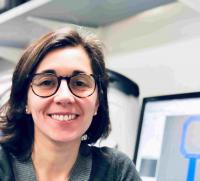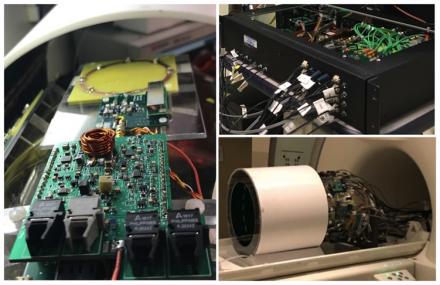
BG 10 RM B1D719
10 CENTER DR
BETHESDA MD 20814
Dr. Natalia Gudino received an Electrical Engineering degree with honors from the National University of Rosario, Argentina in 2003. She pursued her graduate training at Case Western Reserve University (CWRU). First, as a Fulbright Scholar, she developed a steerable catheter controlled by the MRI system at Dr. Mark Griswold’s lab.
After earning her M.Sc. (2008) in Biomedical Engineering, she started her Ph.D. research working on the development of on-coil RF amplification to implement parallel transmission (pTx) in MRI. In a joint collaboration with Dr. Robert Lederman and Dr. Robert Balaban (NHLBI), she explored the impact of this technology on improving RF safety in an interventional MRI setup. After receiving her Ph.D. in 2013, she joined, Dr. Jeff Duyn’s lab at LFMI, NINDS, to develop new on-coil RF amplifiers that can be utilized in ultra-high field MRI (≥7T), and a novel electronic interface that allows control of the new technology by a broad range of commercial systems.
She became a Staff Scientist at the LFMI in 2018. Dr. Gudino is an active member of the International Society of Magnetic Resonance in Medicine and a recipient of the 2017 outstanding teacher award for lecturing RF engineering. As a Staff Scientist and Leader of the MRI Engineering Team, her research mainly focuses on new technologies for RF transmission and signal reception to improve brain imaging at ultra-high field.
Visit the MRI Engineering Team site.
The MRI Engineering Team (MRIEngT) supplies expertise in the design and construction of MRI radiofrequency systems. The major goal is to contribute technology to develop the next generation of ultra-high field systems. Ultra-high field MRI of the brain yields increased contrast, sensitivity, and resolution. To maximize these specifications, the increase in static field should be accompanied by an optimization of the radiofrequency hardware such as transmit and receive coils.
The NIH has acquired an 11.7 MRI scanner– one of only two such scanners in the world- and there is an immediate need to develop custom-built technology to perform pre-clinical studies of the brain. At this field strengths one of the challenges is to have good homogeneity of the excitation field (B1), which is severely compromised due to the short excitation wavelength interacting with the sample that lead to poor image quality.
The MRIEngT is working on new parallel transmission (pTx) approaches to shim the B1 field while ensuring RF safety. Another challenge faced by the MRIEngT is the optimization of detectors to maximize the achievable signal to noise ratio (SNR) at this high field strength and simplify the implementation of high density (>16-channels) RX arrays for parallel imaging. Dr. Gudino has been working on new technology that will facilitate the implementation of pTx systems enabling advances in ultra-high field clinical MRI. Besides her focus on developing hardware for parallel transmission Dr. Gudino’s broad research interests are on designing novel, compact, and low-cost digital and/or analog systems that can improve any aspect of the MRI experiment.

Gudino N. Adaptable Dual-Tuned Optically Controlled On-Coil RF Power Amplifier for MRI. IEEE Trans Biomed Circuits Syst. 2004 Jun 5. Online ahead of print.
Gudino N, de Zwart JA, Duyn JH. Eight-channel parallel transmit-receive system for 7 T MRI with optically controlled and monitored on-coil current-mode RF amplifiers. Magn Reson Med, 2020 84(6):3494-3501.
Gudino N, de Zwart JA, Duan Q, Dodd SJ, Murphy-Boesch J, van Gelderen P, Duyn JH. Optically controlled on-coil amplifier with RF monitoring feedback. Magn Reson Med, 2018 79(5):2833-2841.
Gudino N, Sonmez M, Yao Z, Baig T, Nielles-Vallespin S, Faranesh AZ, Lederman RJ, Martens M, Balaban RS, Hansen MS, Griswold MA. Parallel transmit excitation at 1.5 T based on the minimization of a driving function for device heating. Med Phys, 2015 42(1), 359-71
Gudino N, Heilman JA, Riffe MJ, Heid O, Vester M, Griswold MA. On-coil multiple channel transmit system based on class-D amplification and pre-amplification with current amplitude feedback. Magn Reson Med, 2013 70(1), 276-89
